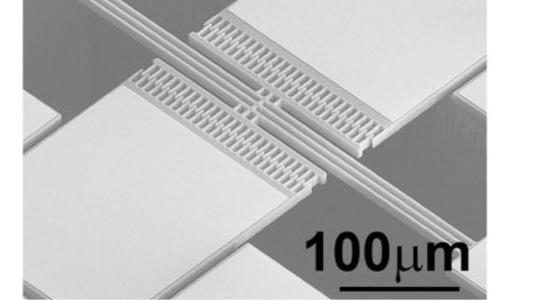
Scientific Achievement
Using a single actuation signal, we generate a novel response—a frequency comb—in a micromechanical resonator and demonstrate the mechanism behind the behavior. Mode coupling can be nonresonant, where the frequencies of the different vibrational modes do not match and result in inefficiency or instability, or resonant, where the frequencies of the different modes satisfy proportional relationships and produce efficient energy transfer or improve stability. Both nonresonant and resonant typically require multiple external signals to create the multiple modes. In this work, using a micromechanical device, we generate both a flexural mode and a torsional mode with a single signal. The two modes have proportional frequencies and couple to generate a “frequency comb.” Further investigation traces the source of the novel behavior to a branching of the vibrational frequency into two stable paths—a bifurcation. A generic model describes the internal resonance using experimental data from the device.
Significance and Impact
This completely mechanical model, which can be easily controlled, may be applied to certain biological systems and possibly as a way to emulate neuron interactions.
Research Details
Standard experimental measurements were used to determine the model parameters from the two vibrational modes, flexural and torsional, whose interactions are responsible for the unique frequency comb response. Capabilities from the Center for Nanoscale Materials include electrical equipment to measure device properties.
DOI:https://doi.org/10.1103/PhysRevLett.121.244302
Work was performed in part at the Center for Nanoscale Materials.
About Argonne’s Center for Nanoscale Materials
The Center for Nanoscale Materials is one of the five DOE Nanoscale Science Research Centers, premier national user facilities for interdisciplinary research at the nanoscale supported by the DOE Office of Science. Together the NSRCs comprise a suite of complementary facilities that provide researchers with state-of-the-art capabilities to fabricate, process, characterize and model nanoscale materials, and constitute the largest infrastructure investment of the National Nanotechnology Initiative. The NSRCs are located at DOE’s Argonne, Brookhaven, Lawrence Berkeley, Oak Ridge, Sandia and Los Alamos National Laboratories. For more information about the DOE NSRCs, please visit https://science.osti.gov/User-Facilities/User-Facilities-at-a-Glance.
Argonne National Laboratory seeks solutions to pressing national problems in science and technology. The nation’s first national laboratory, Argonne conducts leading-edge basic and applied scientific research in virtually every scientific discipline. Argonne researchers work closely with researchers from hundreds of companies, universities, and federal, state and municipal agencies to help them solve their specific problems, advance America’s scientific leadership and prepare the nation for a better future. With employees from more than 60 nations, Argonne is managed by UChicago Argonne, LLC for the U.S. Department of Energy’s Office of Science.
The U.S. Department of Energy’s Office of Science is the single largest supporter of basic research in the physical sciences in the United States and is working to address some of the most pressing challenges of our time. For more information, visit https://energy.gov/science.